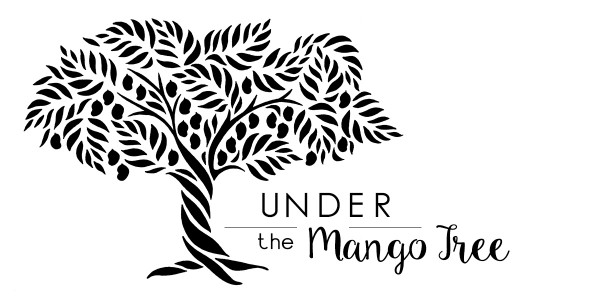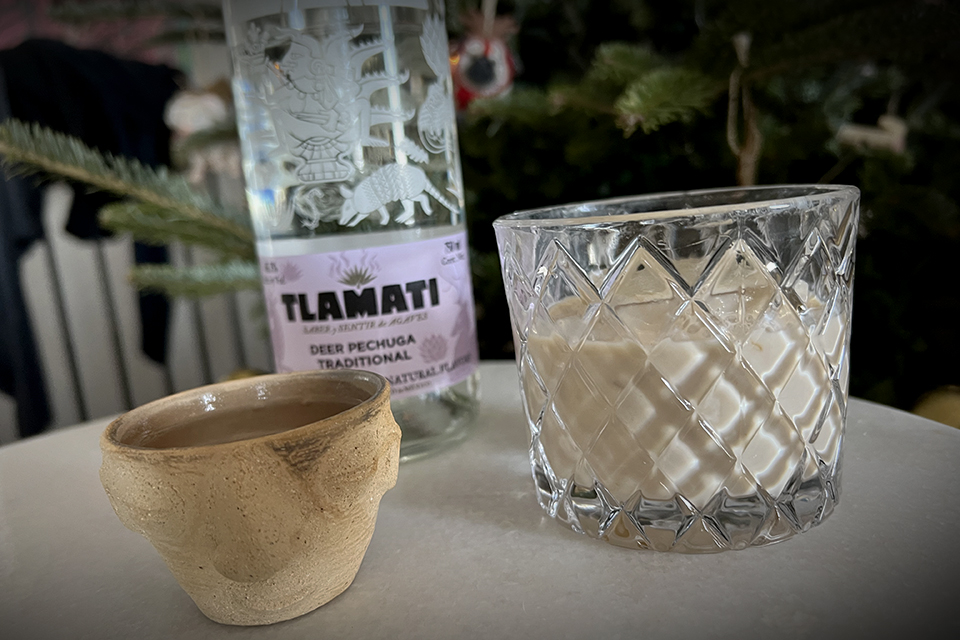A celebratory mango-milk punch for Christmas
I had my first Pechuga, about 30 years ago when I was studying politics in Cuernavaca, Mexico while in college. On one of our outings we visited the then governor of the state of Morelos (where Cuernavaca is located) at his home, to discuss local politics. The governor also happened to produce mezcal. It wasn’t long into the outing when we veered off political course and began indulging in the governors mezcalero side, drinking and discussing mezcal instead. Eventually he pulled out a bottle of his pechuga, or as he humorously described it “mezcal’s breast milk.” After the poorly translated jokes, he went on to describe pechuga to us for real, explaining that it’s a very special and celebratory spirit made by mezcal makers and made with raw chicken or turkey breast as well as a medley of other botanicals, herbs and spices.
Wait, what? The room of 19-20 year old Americans were a bit in shock, even my then weird loving idea self, was aghast with the idea of raw chicken breast used in mezcal.
Fast forward to today, when I recently received a bottle of deer pechuga in the mail, and my even more weird loving idea, wiser self is ecstatic with the idea of pechugas. The creative artistry and ingenuity of flavor and expertise is something I just totally dig.
These days I have such appreciation for cultural artistry when it comes to making food and drink and tend to look for what most might deem weird, the places where traditional and modern ingredients, ideas and art collide; where extraordinarily delicious and seemingly weird food and drink are being created and where these same food and drinks have been created for centuries. This collision point is positively poignant in this moment in my life. Fresh off a similar topic – mole and after that young version of me, the one sipping pechuga in Cuernavaca with the governor, still searching for who she was had finally recognized her own food artistry.
It’s no wonder the Oaxacans are recognized for their artistry in food and drink, they are the ones credited for the birth of Mezcal, as well as mole and they continue to show the world just how incredibly beautiful their artful way of living is.
Pechuga, which is Spanish for breast, is a type of small-batch mezcal that traditionally made by hanging a piece of raw chicken breast inside the still during distillation, often in a sack or basket, like gin producers do with flavorings. The heat and the steam from the distillation process cook the chicken in the process of distillation. The fatty juices from the chicken drip into the mezcal, flavoring it while the vapors from the liquid rise and flavor the meat in a circular flavoring cycle, which adds depth and character. The flavor that is captured is a super savory essence that mingles with the other special ingredients, the end result is a highly complex smoky and savory mezcal, one that feels as special as it tastes.
Mostly, pechugas have been “made-to-order for very special occasions, weddings, births and holidays. As mezcal and pechuga becomes more popular they are being made more often, still in small-batches but new mezcal markets and drinkers are making these specially crated spirits more popular.
Each pechuga is a deep personal expression of the producer or of a communal concept from the village in where the mezcalero lives. There are all kinds of personal, traditional and family recipes; everything from fermented, fresh and dried fruits to exotic spices are included. Teas, tinctures, chili powder and adobo mixes, mushrooms, seeds, honey, botanicals like herbs and flowers and even marijuana can be additives. Even preprepared salsas and moles, which extra intrigues me. There are so many differing recipes, many which have existed for years within families and passed down and new ones are emerging as mezcaleros get more and more creative as artists and as they find valuable markets for their expressionism. Controversial among many purists is the contrasting meats currently being used; lamb, rabbit and even wild game like deer included in some of the finest and most extravagant pechugas. Whatever the mezcalero (and often the families of the mezcaleros: spouses, children, parents contribute to the recipe concept) decides to mix up, the sum of all of these ingredients and essences, slosh around in copper, clay and wood pots, depending on how advanced the mezcaleros process is, creating one of the most unique spirts I have ever encountered, not just in the final taste, but in the creative process and artistry itself. How spectacular to drink something with such a story behind it, it feels as celebratory as it is meant to be.
I was gifted a bottle this year by a friend and decided to share it with my own friends for a little Christmas Mole and Tamale celebration, keeping true to the spirits intentions. Staying true to me and against all the drink expertise ( all the advice said drink it straight, don’t even think of mixin it) – I made a cocktail recipe with it, a mango one, which for me represents my own connection to Mexico and artistry.
If you know me you know I don’t care about the experts, just as I wouldn’t want to deter someone from enjoying herbs or mangoes the way they want to with my expertise blocking or hindering their own tastes and preferences in tasting (and feeling) food and drink joy. Openness to everything must exist, it is after all the exact nature of this particular spirit itself.
I approach these off the path ideas very thoughtfully, as I have done many times, like in my cocktail recipes for high end whiskey’s, my Passionate Whiskey Sour recipe wowed quite a few straight up drinkers. My take is that I want to give more people access to the beauty of the goods and some of these spirits are extremely potent or unique. Mezcal, like scotch is potent and many people I know are put off by drinking it. They don’t get to enjoy the totally unique smokey and savory nuances of Mezcal because of its vigor. Like people who start drinking coffee and need a little sugar or cream, many drinkers need a little dilution in their strong spirits. I don’t see a problem with that, in particular, if you are crafting a recipe that doesn’t take away from the real magic, or in this case one that showcases the pechuga and delivers it in drinkable form
Despite no one else ever mixing a pechuga (which I don’t belive) and despite the fact that I will surely get virtually scolded for doing so- I made a cocktail recipe for my deer pechuga, a bottle that is quite special. Yes’ I’ll make my part goers try the pechuga on it’s own too, but ideally they will get to imbibe in more of the magic by diluting it a bit, of course diluting it so the original essence and flavor is what shines.
The bottle I was gifted is a Tlamati Deer Pechuga (My friend chose this one he said because I live in deer country). Tlamati Spirits (tlamati in Nahuatl means Saber y Sentir or to know and feel) is the producer and they are a small cooperative in Puebla. It’s a father and son duo Balbino and Sergio Salas and in the mezcal world they are extremely reknown (for the distinct creative expressions as well as the craftsmanship) In their Palenque (mezcal distillery) El Individuo, most everything is done in traditional and indigienous methods, earthen ovens, foraged ingredients and distilled in cooper pots, according to Skurnik Wines, who also sells their mezcals. It also described the spirits as an “opportunity to know and feel something deeply Poblano” Puebla being thier home. For me, this sentiment, is everything I work for, not just trying to connect the dots between those that produce the goods and those that consumer the goods but sharing the real essence of who each of us is and how to share it with eachother.
Tlamati Deer Pechuga (Facts and figures- again from Skurnik Wines)
- Maestro Mezcalero: Balbino & Sergio Salas
- Collaboration with chef Jazmín Ponce
- Produced in San Miguel Atlapulco, Puebla
- 100% Papalométl (Agave potatorum)
- Cooked in a conical earthen oven; Milled by hand using wooden mallet & canoa as well as with a small mechanical grinder
- Fermented with ambient yeast and spring water in stainless steel tanks
- Distilled three times using a traditional copper pot still
- Addition of venison (deer) and adobo spice on the third distillation
- Wet moss, old leather, fresh bricks, cumin, chili, anise, on the nose; palate bursts with fruit such as plantain, strawberry, and dates, alongside distinct umami mushroom notes, roasted parsnip, sea salt, and a bit of Cadbury’s crème egg. Delightful and a bit too easy!
- 46.1% ABV (Alcohol may vary batch to batch)
- Only 73 bottles produced in this batch
Upon tasting my gifted bottle of Tlalmati in order to figure out my cocktail recipe I took notice to the incredibly savory aspect of the spirit and the incredibly sweet spice nose. The mezcal smokiness was potent so were the Mexican spice and chili aromas intermingling together. It feels grassy which all coupled together creates a totally new wildspice scent, in my mind I don’t smell deer, but I do feel a pleasant and funky wild essence that could be form the wild venison.
I finally landed on boozy milk punch recipe, using mangoes ( after all the tie in between Mexican mangoes and mezcal is what I want). I like the idea of a creamy “eggnog-esque” drink for its Christmas celebratory factor and thought this could let the pechuga offer what it was designed to straight. The spirit had a “fatty” mouthfeel to it and I thought that could handle the cream and the cream can also bring out the mezcals grassy notes and vice versa (circular like what happens in the still). The mango melds into the spices adding a tinge of fruit, the smokiness tames the sugar, making the spirit more palpable for the laymen palette and I believe not taking anything away from the original.I am amble to coax out more spice with the sweet perfumy nature of the mango. I decided not to batch these but to make them one by one, taking the time needed to do each perfectly and on demand, keeping closer to the the way people drink it straight. The fat of the cream gently intermingles with the fat of the deer and wild and grass shine through and create a silky and fatty mouthfeel, which I am in live iwht. Over all I think I wont let anyone down with this and most importantly I can guarantee at least a few more folks in this world will know the beauty of Mexican pechuga and its makers!
Saber Y Sentir (Mango Milk Punch)
Ingredients
For the mango cream nectar
1 cup cubed fresh mango
¼ teaspoon vanilla
2 tablespoons brown sugar
1/4 teaspoon ground cinnamon
1/4 teaspoon ground nutmeg
1 cup whole milk (good quality)
For the cocktail
1 ounce mango cream nectar
2 ounce Tlamati Deer Pechuga
Ice
Directions
For the mango cream nectar.
Blend the mixture up in a blender and then warm for about 3 minutes. Remove from heat and allow to cool. Refrigerate.
For the cocktail
Add the ingredients in a large mixing glass half full of ice. Stir untilled well chilled. Strain into a coup style glass or alternatively serve over ice in rocks glass.













No Comments